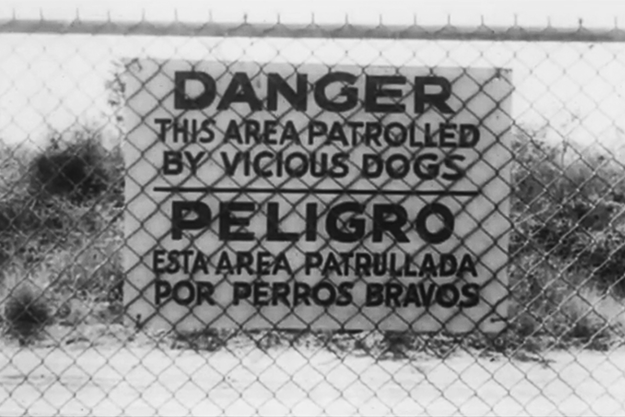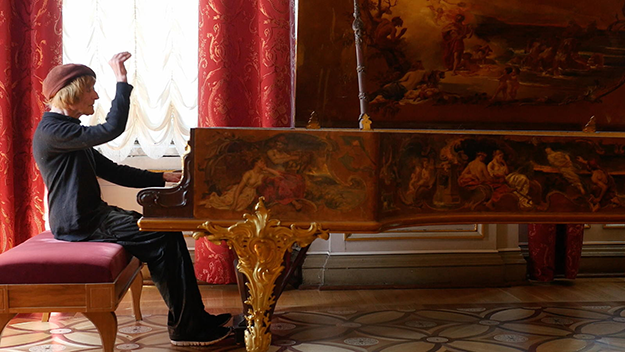Festivals: Doclisboa 2016

Guantánamo
Now in its fourteenth year, Doclisboa is among a growing number of contemporary film festivals, including FID Marseille, Cinéma du reel, True/False, and RIDM, that support a particularly radical species of documentary, one that embraces a wide range of aesthetic practices (narrative, experimental) and forms (medium-length works, video installation). What distinguishes the festival, though—apart from its emergence from Lisbon’s vibrant and tightly knit film community—is its special emphasis on the political. Alongside its international and domestic competitions and a crowd-pleasing sidebar devoted to music-themed films, the festival priorities seem to lie in a type of socially engaged work that might be termed, after another of Doclisboa’s sidebars, “Cinema of Urgency.” This meeting of radical aesthetics and aestheticized radicalism doesn’t always strike a perfect balance, but it nonetheless makes for a bold and volatile mix.
The key to any festival’s ambitions often lies in its retrospectives, and here Doclisboa’s programming was especially revealing. Next to tributes to the late Peter Hutton and the Dutch video artist Manon de Boer, the festival undertook a rare complete retrospective of the British filmmaker Peter Watkins and a sizable 12-program series of works from post-revolutionary Cuba. The latter in particular was instructive of the aesthetic possibilities of a revolutionary cinema. Curated by documentary scholar Michael Chanan, “For an Impossible Cinema: Documentary and Avant-garde in Cuba Retrospective” is an exhaustive (almost exhausting) foray into Cuban documentary filmmaking from roughly the first dozen years of the revolution. But the program revealed this period an exhilaratingly heterodox approach to documentary, very far from the kind of hardline, aesthetically unified cultural program that one might expect.
Beginning with a somewhat conventional neorealist film—Julio García Espinosa’s El Mégano, a pre-revolution short from 1955 depicting the arduous swamp work of a group of exploited rural peasants—the program soon moved on to take in a more varied and vibrant political cinema. This included works by visiting auteurs such as Joris Ivens, Chris Marker, Agnès Varda, and Robert Drew, but also gave due prominence to renowned domestic directors like Sara Gómez, maker of several elegant ethnographic portraits of Isla de la Juventud and Santiago de Cuba, and Santiago Álvarez, whose style of “nervous montage” galvanized the country’s filmmaking in the years after the revolution. Focusing on the extraordinary variety of documentary practices in Cuba at the time, the program features some unlikely suspects, including future New Wave cinematographer Néstor Almendros, whose observational Gente en la Playa (1960) documents the first day of deprivatized beaches in Cuba, and Tomás Gutierrez Alea, best known as the director of Memories of Underdevelopment, represented here by a newsreel covering Castro’s 1960 assemblea general that convened about a million people in Havana’s Revolution Square. Testifying to the sheer breadth of radical film practice at the time, José Massip’s Guantánamo (1967) unleashes a full arsenal of documentary strategies on its tortured subject, dissecting the town’s relationship with its military imperialist occupiers through smash-cut archival footage, stylized reenactments, jagged photomontage, musical performances, and interviews filmed in tracking shots à la Chronicle of a Summer.

Rat Film
This radical experimentalism in form extended to the festival’s contemporary offerings as well. Theo Anthony’s Rat Film takes up a similar array of documentary forms to grapple with the hidden layers behind the issue of rat control in the city of Baltimore. Rodent-averse viewers might be wary of such a film—and, indeed, there are one or two sequences that test the spectator’s rat-threshold, like the early shot of a particularly large specimen trapped at the bottom of a trash can leaping toward the camera lens. But of course the movie is much less about furry creatures than their larger co-species: as one charismatic city exterminator says, “It ain’t never been a rat problem in Baltimore. It’s always been a people problem.” Anthony underlines the way that the state’s efforts to manage rodent populations line up all too closely with those to manage low-income, African-American ones. Floating through Google Earth–rendered neighborhoods, Rat Film makes clear—through a flat voiceover narration that’s somewhere between Siri and what you’d hear in a Harun Farocki film—that Baltimore’s history of pest management is part of a more pervasive effort to organize urban spaces and populations. The weight of civic resources—against crime, poverty, unemployment, and financial instability—all come down on the same Baltimore neighborhoods in the form of social experiments, scientific studies, city initiatives, and, yes, pest control. And Rat Film makes all of this comprehensible through a complex integration of interviews, observational photography, archival elements, and even a dash of apocalyptic sci-fi, accentuated by a sinister electronic score by Dan Deacon.
Given the festival’s capacious definition of the documentary mode, a number of its best films hybridize actuality and fiction into complex—and occasionally baffling—new forms. Colombian director Laura Huertas Millán’s Black Sun, winner of a Special Mention for Best Competition Film, is a medium-length work that mixes memoir and melodrama. The film drifts between a rehab clinic, a dinner table, an abandoned theater, and a barren, twilit outcropping, playing with themes of trauma and therapy, familial estrangement and various modes of healing, training, and catharsis. Between these two spaces are three women: Antonia, an opera singer and, it seems, a resident of the clinic; her estranged older sister, who scrolls through Antonia’s Facebook page for clues about her life; and the filmmaker herself, daughter of the latter sister, who serves as interlocutor and medium. Her intervention seems to provide the necessary link to bridge the film’s many fragmented locations and states of being—in an effort, as her mother later says, to “conserv[e] the family link but without the cord of sorrow.” Made in affiliation with Harvard’s Sensory Ethnography Lab but bearing few of its stylistic hallmarks, Black Sun works mysteriously, through dismantled sequences and elusive editing, tight frames and dim lighting, toward a form that refuses to extricate past from present, the imaginary from the real.
Bertrand Bonello’s 24-minute Sarah Winchester, Opéra Fantôme veers still deeper into the realm of fiction—or fantasy even, metaphorically recasting the famously delusional heiress of the Winchester Repeating Arms Company as Gaston Leroux’s malevolent backstage denizen. The operas in question are the Opéras Bastille and Garnier, as well as an “unfinishable” opera about Sarah’s life, related through rehearsals, intertitles, and grim watercolors. These are the particulars: after the death of her daughter, the heiress to fortunes made through the vast destruction of human life during the Civil War becomes haunted by the ghosts of its victims and decides to expand her cavernous mansion into a vast “mystery house” to accommodate them all. Bonello succinctly re-creates this impossible biography through its loose components: a dancer and her director rehearse of a solo set to techno; a choir echoes the ghost-chorus’s eerie cries of Sarah’s name; and a bloodied child wanders barefooted through the Opéra’s vast complex. It’s a film of strange contrasts and concordances: the striking presence of the dancer’s body set against the Winchester rifle’s unseen destruction of flesh; modern and classical musical forms; the gold opulence and chandeliers of the theater and the modern machinery backstage.

Oleg and the Rare Arts
A rather more charming, if only slight more corporeal, ghost of the past haunts Andrés Duque’s Oleg and the Rare Arts, the festival’s opening-night selection. A portrait of the Russian pianist and composer Oleg Nikolaevitch Karavaychuk, who died this past June, Duque’s film introduces us to its subject wandering the halls of the Hermitage Museum, muttering, dreaming, seemingly lost in world long since gone, if it ever existed at all. The eightysomething Karavaychuk makes for an eccentric presence to say the least—spindly armed, shrill-voiced, androgynous, and foppishly arrayed in a Prince Valiant haircut and puce beret. Oleg and the Rare Arts is utterly enthralled by the pianist’s presence, and cinematographer Carmen Torres follows every sway, every reverie, as Karavaychuk spins wayward yarns (about being neighbors with Anna Akhmatova and Arseny Tarkovsky in a Petersburg artists’ colony provided by Stalin, for example) or unfurls his exquisite, otherworldly compositions in a style that seems closer to Cecil Taylor than Rimsky-Korsakov. Those familiar with Duque’s recent films Color Runaway Dog (2011) and Dress Rehearsals for Utopia (2012), extreme experiments in montage that mix personal, political, and cinematic histories, might be surprised to find a work that is composed of lengthy, hypnotic takes. (I’d be surprised if there’s more than 50 shots in the entire film.) But to call this simply an “affectionate” or “reverent” portrait would be misleading—it’s a movie completely under Karavaychuk’s weird spell, and it envelopes its audience in his strange, rhythmic, and vividly color sensibility with a remarkable tenderness.
A decidedly less successful attempt at portraiture, Ismyrna is at least ostensibly a study of the poet and painter Etel Adnan by the artists Joana Hadjithomas and Khalil Joreige. Its portmanteau title merges two names for the same city—Turkey’s Izmir, once called Smyrna—as well as the family narratives of both Adnan and Hadjithomas, whose relatives both fled the city decades prior. But the merger is frustratingly uneven: the film lingers on Hadjithomas’s reminiscences at the expense of Adnan’s—surely the more compelling subject—and becomes enmired in endless shots of the younger artist wandering pensively around the city and badly cropped and illegible archival footage. Once back to Adnan’s flat in Paris to reconnoiter, Etel herself doesn’t seem especially taken with the artists’ findings, leaving one to wonder what purpose the poet’s presence serves (other than as a boldface name to append to one’s project). The work’s attitude toward its purported subject unfortunately comes off as more cynical than curious, and the film’s formal vagueness doesn’t help to justify its existence.
With an infinitely more engaged approach to its subject, Cláudia Varejão’s Ama-San was a clear favorite in the Portuguese Competition. A languidly paced and exquisitely photographed portrait of a small group of mostly older women from the small Japanese fishing village of Wagu, the film follows these women as the bearers of a millennia-old tradition of free diving for abalone, sea urchins, and oysters off the Ise Peninsula. It’s clearly an arduous occupation, but the film endows it with an almost mythological power, documenting the dives in visually stunning and aurally immersive sequences. But the women are also gardeners and grandmothers and cooks and karaoke singers, and Ama-San balances the more dramatic scenes with rather subdued scenes of domestic downtime shot in tight focus to emphasize their intimacy. Along with the very best works of the festival, the film finds a state of equilibrium among these elements, suggesting that form and function, or the everyday and the epic, are not purely oppositional but in fact rather more deeply ingrained in one another.







